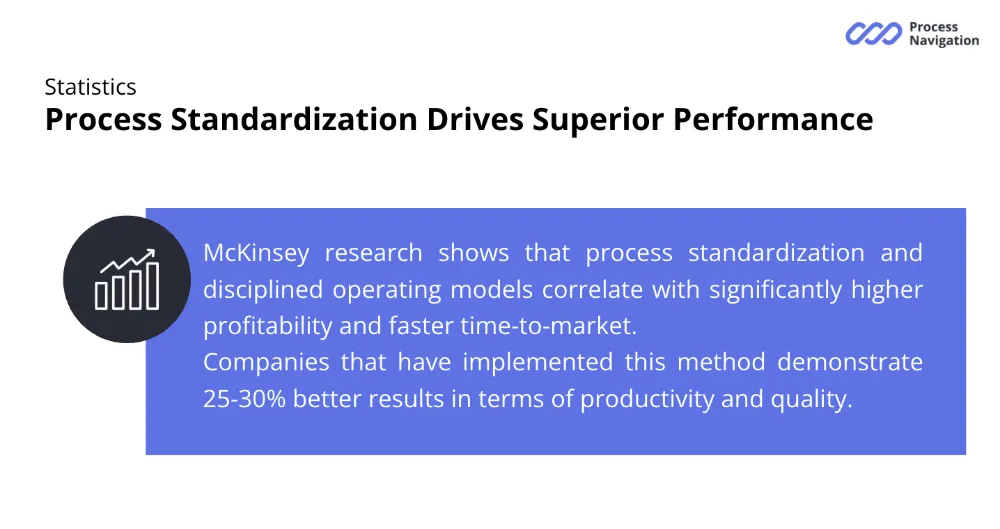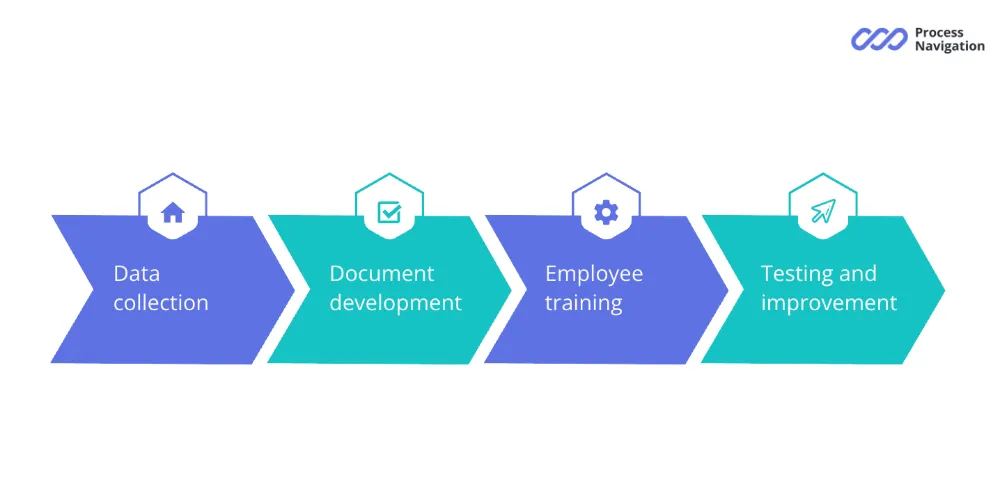Imagine a factory where every employee performs the same tasks differently. One spends 5 minutes on the task, another 15. The result? Chaos in production, unpredictable quality, and constant rushes.
Standard Work is precisely the tool that transforms chaos into a well-oiled system. McKinsey research shows that process standardization and disciplined operating models correlate with significantly higher profitability and faster time-to-market.
Companies that have implemented this method demonstrate 25-30% better results in terms of productivity and quality. Effective work instructions help reduce production time significantly while ensuring consistency across all operations. A comprehensive standard work template helps streamline the production process and eliminates process variation across different shifts.
Creating effective standardized work instructions requires identifying all key elements of the production process and providing clear tools for employees to perform their tasks efficiently. Using a detailed standard work instructions template guarantees that every step is supported by concise instructions and visuals.
Standard Work: Definition and Philosophy
Standard work is a detailed and documented method for performing work operations that ensures maximum efficiency at minimum cost. It is the most efficient method for performing a specific task at the moment, formalized in a document and supported by all employees. A well-designed standard work template ensures consistency and includes all materials needed for each task.
Unlike instructions, it includes not only a sequence of actions, but also cycle time, standardized inventory, visual elements, operation balancing, and training. Standard operating procedures built into standard work help eliminate process variation and create consistency throughout the organization.
The standard work philosophy is based on three principles:
- Stability as the foundation for growth. It is impossible to improve something that is constantly changing. Standards create a stable basis for measurement and improvement.
- Involvement of every employee. The best ideas come from those who perform the tasks every day. Standard Work makes every participant in the process a co-owner.
- Continuous improvement. A standard is not a “freeze” on the process, but a platform for continuous growth and innovation. Work instructions serve as the foundation for continuous improvement initiatives.
Key Elements of Standard Work: the Anatomy of Efficiency
| Element | Purpose | Definition |
| Takt Time Calculation | Synchronization of production with customer needs | Time = Available time / Customer demand |
| Cycle Time Analysis | Comparison of actual time with required time | Basis for identifying bottlenecks and errors |
| Job Element Sheet (JES) | Detailing each step of the operation | Includes critical quality and safety points |
| Standard Work Combination Sheet (SWCS) | Visualization of manual labor, machine time, and movement | Shows optimal use of resources and tools |
| Production Capacity Sheet | Calculation of available power on the line | Basic planning element |
| Standard Work Layout Sheet | Workstation layout showing the optimal placement of equipment and operator movement route | Minimization of unproductive movements |
| Standard In-Process Stock (SWIP) | Minimum fixed buffer between activities | Ensuring flow stability |
| Visual Work Instructions | Simplification of training and control | Photos, diagrams, video instructions |
| Kaizen Burst | Identification of areas for potential improvement | Systematic work with proposals |
Understanding takt time is crucial for creating effective work instructions that synchronize production with customer demand. Visual aids incorporated into standard work instructions template help operators complete each task more efficiently and reduce errors in the production process.
The Connection between Standard Work and Lean Manufacturing
Standard work is one of the basic elements of the Lean philosophy, without which it is impossible to build an effective production system. Lean manufacturing principles are deeply integrated into standardized work instructions, creating a comprehensive approach to operational excellence.
It is the foundation for:
- Just-in-Time (JIT): stable cycles allow for accurate delivery planning.
- Jidoka: quality standards are built into every operation.
- Kaizen: improvements are based on measurable deviations from the standard.
- Heijunka: production levelling is only possible with standardized cycles.
- Poka-Yoke: error prevention is built into standard procedures.
Lean manufacturing methodologies rely heavily on detailed work instructions and tools to ensure consistency and eliminate waste. Quality control becomes an integral part of every lean manufacturing process through tools and instructions. A comprehensive standard work template helps standardize processes across different departments and tasks.
5S and Standard Work: a Symbiosis of Efficiency
The 5S methodology creates the physical foundation for standard work:
- Seiri (Sorting): remove unnecessary items from the workspace.
- Seiton (Systematization): arrange tools according to a standard layout.
- Seiso (Cleanliness): maintain cleanliness standards.
- Seiketsu (Standardization): establish best practices.
- Shitsuke (Sustain): continuously improve standards.
Work instructions are essential for maintaining 5S standards and ensuring consistency in workplace organization. Standard work instructions provide clear guidance for each task while incorporating visual aids to support operator understanding.
The Benefits of Implementing Standard Work in Numbers

Manufacturing and Operational Advantages
Standardized work practices improve productivity, reduce defects and errors, accelerate changeovers, and enhance overall equipment effectiveness (OEE).
Using a standard work instructions template ensures consistency and allows employees to be trained systematically on every critical task.
Operational Advantages
- Faster onboarding and training of new employees
- Higher employee retention and engagement
- Lower quality control and rework costs
- More predictable and stable process outcomes
Employee Benefits
- Clear expectations and evaluation criteria – everyone knows what is expected and how performance is measured.
- Reduced work-related stress – clarity on tasks minimizes uncertainty.
- Equal opportunities for growth – standardized processes support fair development paths.
- Fair evaluation and rewards – performance assessments are consistent and transparent.
- Active participation in improvement – employees can contribute through suggestion systems.
Work instructions give employees concise guidance and the tools they need to complete key tasks safely and efficiently.
Customer Benefits
- Consistent quality of products and services.
- Adherence to promised delivery times.
- Predictability of service at all stages of interaction.
Instructions help maintain consistency in both customer service delivery and product quality.
Standard Work Examples
Standard operating procedures in each area require specific work instructions to ensure consistency and optimal performance.
| Area | Example of use |
| Production | The manufacturing standard work template on the assembly line includes:Calculation of cycle times, cycles, and standard inventories.Use of a visual management board at the place of execution.Standard work instructions template covers each task in the production process with detailed visual aids. |
| Office | Standard work template for offices helps:Optimize routines: processing requests, approvals.Implement standards for HR, accounting, and procurement.Work instructions template standardizes administrative processes and ensures each task follows established protocols. |
| Logistics | The introduction of standard in-process stock in the picking area has improved inventory control and reduced errors by 25%. |
| IT | Visual work instructions and one-point lessons are used to manage incidents, allowing new employees to get up to speed more quickly. Standard work instructions template helps IT teams standardize troubleshooting processes for each type of task. |
How to Implement Standard Work: a Step-by-step Guide
A systematic approach to implementing this method requires clear planning and step-by-step implementation. Here are key points:

1. Data Collection
- Measure current cycles, losses, operator workload.
- Calculate takt time and identify bottlenecks (using yamazumi chart or work balance chart).
Work instructions should be developed based on accurate process variation analysis to ensure consistency.
2. Document Development
- Create a standard work sheet using templates.
- Include visual diagrams, times, SWIPs and checklists.
Work instructions templates must include safety precautions and concise instructions for each step of the work process.
3. Employee Training
- Use operator certification sheet and visual work instructions.
- Use one-point lesson for individual stages.
Training sessions should focus on helping new employees understand work instructions thoroughly and apply them consistently.
4. Testing and Improvement
- Implement a standard work audit checklist and standard work compliance tracker.
- Maintain a continuous improvement ideas log.
Regular review of work instructions helps maintain ensuring consistency and continuous improvement.
Standard Work Template: Modern Tool Base
Work instructions templates have evolved from simple paper documents to sophisticated digital platforms that support interactive learning and real-time updates.
Evolution of Standardization Tools
| Generation | Characteristics | Examples of solutions | Restrictions |
| Paper | Static documents, manual update | Word templates, laminated sheets | Difficulty updating, loss of versions |
| Digital | Electronic documents, centralized storage | SharePoint, corporate portals | Lack of interactivity, difficult search |
| Interactive | Dynamic instructions, feedback | Specialized platforms, mobile applications | Technical support is needed |
| Smart | AI assistants, automatic optimization | AI-powered platforms, IoT integration | High cost of implementation |
ProcessNavigation is a digital platform that unites all modern tools for standardized work in a single ecosystem.
The platform allows to:
- Create interactive work standards with step-by-step instructions.
- Embed videos, photos and diagrams directly into work processes.
- Track compliance with standards in real time.
- Collect suggestions for improvement from employees.
- Automatically generate reports on KPIs.
- Integrate with existing corporate systems.
The platform’s special feature is the ability to quickly create standards without programming. Managers can independently configure workflows and update instructions.
Measuring the Effectiveness of Standard Work
The right metrics system allows you to quantify the impact of the method and identify areas for further improvement.
Work instructions effectiveness can be measured through improved consistency metrics.
Comprehensive System of Metrics
| Level | Metrics | Calculation formula | Target value | Measurement frequency |
| Operational efficiency | Maintaining a standard cycle | (Operations per clock / Total) × 100% | > 95% | Daily |
| OEE (Overall Equipment Effectiveness) | Availability × Performance × Quality | > 85% | Weekly | |
| First Pass Yield | (Products without defects / Total volume) × 100% | > 98% | Daily | |
| Quality of processes | Cycle stability | Standard deviation of cycle time | < 10% of average | Weekly |
| Number of deviations from the standard | Number of recorded violations during the period | < 5 per week | Daily | |
| Response time to problems | Average time from detection to resolution | < 15 minutes | In fact | |
| Personnel development | Time to learn for new hires | Days to independence | < 14 days | By new employees |
| Level of involvement in improvements | Number of offers per employee | > 2 per months | Monthly | |
| Percentage of certified employees | (Certified / Total) × 100% | 100% | Monthly | |
| Financial indicators | ROI from standardization | (Benefits – Costs) / Costs × 100% | > 300% per year | Quarterly |
| Reduced rework costs | Relative to the base period | -70% | Monthly | |
| Labor productivity | Output per hour | +25% to base | Weekly |
SMI: Standardization Maturity Index
| Level | Characteristics | SMI rating |
| 1. Elementary | Lack of documented standards | 0-20 |
| 2. Definite | Basic standards have been created | 21-40 |
| 3. Managed | Standards are observed and monitored | 41-60 |
| 4. Measurable | Performance metrics implemented | 61-80 |
| 5. Optimizing | Continuous improvement based on data | 81-100 |
Common Mistakes during Implementation and Problem Solving
| Mistake | Problem | Solution |
| Too detailed standard work instructions | 20 pages of instructions that no one reads | One-point lesson — one page for one operation |
| Standards “on the drawer” | Beautiful documents are in folders | Visual management board directly at workplaces |
| Lack of updating | Standards have not been updated for months | Continuous improvement ideas log with regular revision |
| Ignoring the opinion of operators | Standards are written by managers without the participation of performers | Involving employees in development from day one |
| Lack of control | No verification of compliance with standards | Standard work compliance tracker and regular audits |
Standard Work Instructions: Template for Free
1. Standard Work Sheet — the main document for operators.
- Complete based on the timing of actual processes.
- Be sure to include a workplace diagram.
- Update regularly when the process changes.
Work instructions templates should be customized to reflect specific work instructions requirements for each operation.
2. Job Element Sheet — for detailed analysis of tasks.
- Use to identify time losses.
- Helps optimize operator workload.
- Basis for making improvements.
Work instructions templates for job element analysis help identify opportunities to reduce production time.
3. Production Capacity Sheet — for production planning.
- Calculate weekly or when changes occur.
- Use to identify bottlenecks.
- Basis for planning equipment workload.
4. Audit Checklist — to monitor compliance with standards.
- Conduct audits regularly (weekly/monthly).
- Adapt the criteria to the specifics of your process.
- Use the results to improve standards.
Work instructions templates for auditing ensure consistent evaluation of work instructions compliance across all shifts.
All these templates can be implemented digitally using the Process Navigation platform, which provides:
- Automatic calculation of indicators.
- Integration with corporate systems.
- Mobile access for operators.
- Real-time analytics.
FAQ
For a pilot site — 2-3 months. Full implementation in a company can take 6-12 months depending on the scale.
Reviews are recommended every 3-6 months or when working conditions change. Minor adjustments are made as suggestions are received.
Compare before/after indicators: productivity, quality, staff training time, number of errors. Typical payback is 3-6 months.
Work instructions should be designed as modular work instructions that can be easily adapted to changing requirements. Create modular standards with a basic part and additional blocks: – Basic process for 80% of cases. – Additional modules for special situations. – Decision tree for choosing the right module. – Quick update system via digital platform.
In this case we suggest creating a self-updating system: – Assign “process owners” to each standard. – Automatic revision reminders every 3-6 months. – Suggestion system via QR codes directly on standards. – Integrate updates into product/service change procedures. Self-updating work instructions systems help maintain current and relevant work instructions as operations scale.
-
 Maintenance Plan: What Is It And How Does It Work
Maintenance Plan: What Is It And How Does It WorkIn modern manufacturing, equipment downtime costs businesses thousands of dollars an hour. The difference between...
Technology
-
 Competency Management
Competency ManagementModern businesses face a big challenge: how do you ensure every employee has the skills...
Technology
-
 Unlocking the Benefits of Total Quality Management
Unlocking the Benefits of Total Quality ManagementIn today’s competitive world, the quality of products and services is becoming the key to...
Technology
